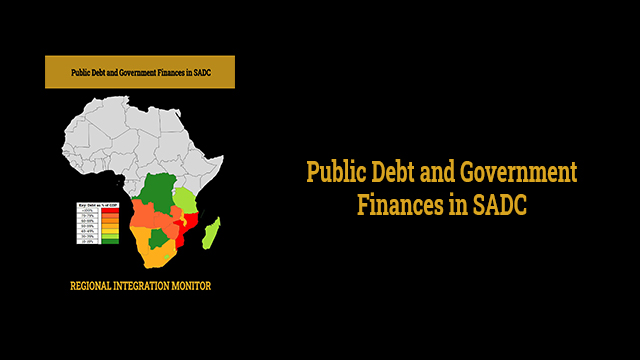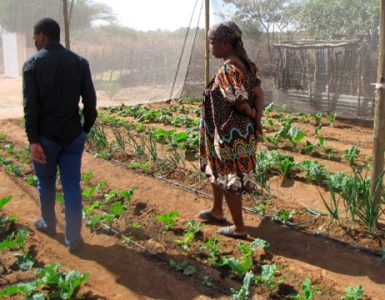Industry Spotlight: Public Debt Instruments
Governments rely on domestic resource mobilisation through taxes, excise and customs duties, royalties and other primary sources of government revenues to finance their national budgets[12]. However, domestic resource mobilisation is jeopardised by weak revenue management institutions and slow economic growth which result in less government revenues[13]. This affects the government’s ability to stimulate domestic demand and support economic growth during recessions or sustained periods of slow growth. Hence, governments borrow from domestic and foreign sources to finance their budget deficits or revenue shortfalls for operational and public investment towards socioeconomic development[14]. Public debt needs to be effectively managed to stimulate economic growth and ensure that the government is able to repay its debts. Poor public debt and fiscal managements leads to rising public debt-servicing costs and debt distress. Therefore, public debt sustainability is determined by the terms of financing as well as how government spend their financing.The pressure on governments to demonstrate tangible economic development progress pushes governments to embark on public infrastructure projects which can raise spending and public debt sharply[15]. For example, Angola’s government decided to revitalise the national textile industry using Japanese loans valued at USD 1.1 billion with 35.0% of this allocated to rebuild the Satec textile factory in Dondo in 2015[16]. As a result, total government spending increased from an average of 37.0% between 2011 and 2014, and 27.0% of GDP in 2015. Angola’s public debt rose from an average of 32.3% of GDP from 2011 to 2014, to 75.3% of GDP in 2016[17]. Sometimes, governments receive poor value-for-money on its investments which has the same negative impact. In Zambia, the Lusaka-Ndola Dual Carriageway road project cost USD 1.2 billion, which is approximately USD 3.8 million per km for the 320 km of road between the two cities[18]. Consequently, government spending increased from an average of 22.3% between 2011 and 2014, and 28.1% of GDP in 2015. Zambia’s public debt increased from an average of 27.4% from 2011 to 2014, to 63.1% of GDP in 2017[19].
Government spend their revenues on three categories of expenditures which includes current expenditures (e.g., paying employees and interest on public debt); fiscal transfers and subsidies (e.g., providing social welfare or other grants); and capital expenditure (e.g., acquiring fixed or financial assets)[20]. Increasing capital expenditure on economic infrastructure and industrial development is considered a desirable strategy because it to supports economic growth and increases government revenue which reduces reliance on debt. Despite the necessity for social transfers and social infrastructure investment in order to reduce poverty and transform society, it is very important for governments to consider whether a specific project will provide sufficient economic returns in order to ensure fiscal sustainable or service public debt[21]. This means that government must match their finance with the needs that the funding will serve.
Domestic borrowing is considered more favourable than external borrowing because it is less vulnerable to market volatility and does not expose public debt to currency risk like international bond markets[22]. However, domestic borrowing is less favourable due to relatively higher real interest costs and shorter maturity compared to external borrowing[23]. For example, Eurobond maturities tend to have a long-period of payment than for debt issued in the domestic markets[24]. In addition, difficulty to maintain sufficient foreign exchange reserves to balance international payments leads to greater risk of rollover or debt defaults[25].
Short-term and medium-term debts are regarded with lower interest portion, but with a higher debt-service cost which can pose as a significant cash-flow risk to government. However, short- and medium-term debts are often subject to the risks of rollover due to cash flow constraints. The higher rollover risk is mitigated by a relatively higher interest rates, which raises the debt servicing costs considerably for short- and medium-term debt instruments[26]. Long-term debt usually attracts a relatively lower interest rate due to lower risk of roll-over which reduces the debt-service cost. However, long-term debt is associated with higher interest portions because the lower interest rate is paid over a much longer tenure or maturity period. Hence long-term debt provides prolonged and relatively cheaper debt-servicing costs which provides more liquidity and reduces cash flow risk[27]. The interest rate and tenure of the financial instrument is the most important considerations that governments make before acquiring debt. In addition, government need to choose the type of financial instruments to meet its financing needs from a range of debts instruments such as Treasury bills, bonds and loans from other foreign and locally-owned financial institutions[28]. The decision on which instrument is often tied with domestic debt managements policies prescribing the optimal amount of debt that the government should hold in the various instruments and the proportions of domestic and foreign-denominated debts.
Treasury bills (T-bills) and government bonds are usually issued by the national government or relevant stock market. These financial instruments are used to meet government financing needs and for the purpose of monetary policy[29]. T-bills offers short-term maturities less than 1 year and lower returns to investors, while bonds offer long-term (5-, 10-, 20- or even 30-years maturities and higher returns to the investors. T-bills present less risk from potential financial losses for government, whereas bonds are subject to volatility with high interest rate risk for government, and the risk of the government defaulting on bond payments for investors[30]. The advantage of using T-Bills and government bonds is that the government determines the borrowing conditions and how to direct the funds to specific investment project. However, this is linked to higher interest costs and political risks such as government being “captured” by a particular group of private investors or financing interests[31]. Foreign denominated bonds like Eurobonds are similar, except they are not issued by the sovereign and they still face currency risk which makes them less desirable than government bonds.
The final borrowing option for governments is bilateral, foreign and domestic, loans and project finance. Loans and project financing as debt instrument give the lenders strong bargaining power to determine the borrowing conditions and where to direct the funds – either into government coffers or directly to service providers. Often, loans and project finance are linked to the economic performance of the recipient countries[32]. Project finance can also be issued through a mixture of local and foreign currency to blend the risk, avoid dependency on foreign funds, and reduce currency risk[33]. Financial Institutions such as International Monetary Fund, World Bank, Paris Club or Organisation for Economic Cooperation and Development offer concessional loans and development finance to governments. Concessional funding is more attractive because it comes with lower or no interest and the lenders often can decide to write off the debts[34]. Concessional funding is always provided at lower interest rates than commercial finance and sometimes it comes with added support to bridge technical or other gaps throughout the life cycle of the project. Grants are the most preferred form of concessional funding because they are provided for politically-visible purposes like social infrastructure, without the obligation to repay, and can sometimes be directed for current expenditure or budget support directly to government coffers[35].
To sum up, at large extend SADC countries needs enormous resources to undertake socioeconomic development programmes to enhance the living conditions of citizens. However, government fall short to mobilise enough resources to finance and meet their developmental goals. That is why governments make decision whether to use domestic and foreign financing instruments which is imperatively linked to maturity period, interest rate and flexibility of terms of payments. As mentioned above, it is very important to consider the advantages and disadvantages, and other conditions (such as taking into account money borrowed in local currency or foreign currency, and exchange rate) associate by using the different financing instruments, while its raises the issue of the capability of repayment of the governments and whether borrowed money by the government is directed into investment that create productive and value added activities capable to sustain public debt and contribute to support economic development. Hence, these instruments need to be used very cautiously to avoid unsustainable public debt management and worsening the fiscal deficit.
By Serge Hadisi
[12] IMF 2001. Government Finance Statistics Manual, International Monetary Fund: Washington, D. C. Available At: https://www.imf.org/ [Last Accessed: 2 February 2019].
[13] Lopes da Veiga, J., Ferreira-Lopes, A., & Sequeira, T. 2014. Public Debt, Economic Growth, and Inflation in African Economies, Munich University: Munich. Available At: https://mpra.ub.uni-muenchen.de/ [Last Accessed: 21 December 2018]; IMF 2001. Government Finance Statistics Manual, ibid.
[14] Were, A. 2018. Debt Trap? Chinese Loans and Africa’s Development Options, South African Institute of International Affairs: Johannesburg. Available At: https://saiia.org.za/ [Last Accessed: 21 December 2018]; Wentworth, L., Markowitz, C, Ngidi, Z., Makwati, T., & Grobbelaar, N. 2018. SADC Regional Development Fund: Operationalisation Imminent?, Global Economic Governance Africa: Pretoria. Available At: http://www.gegafrica.org/ [Last Accessed: 21 December 2018]; IMF 2001. Government Finance Statistics Manual, ibid.
[15] Lopes da Veiga, J. et al. 2014. Public Debt, Economic Growth, and Inflation in African Economies, ibid.
[16] AHK 2017. Angola, Southern African-German Chamber of Commerce and Industry: Johannesburg. Available At: http://suedafrika.ahk.de/ [Last Accessed: 11 January 2019].
[17] IMF 2018a. World Economic Outlook Database, ibid.
[18] Cheelo, C.2018. Financing the Economic Stabilisation and Growth Programme (Zambia Plus) in the Shadow of the IMF, Zambia Institute for Policy Analysis and Research: Lusaka. Available At: https://www.africaportal.org/ [Last Accessed: 11 January 2019].
[19] IMF 2018a. World Economic Outlook Database, ibid.
[20] IMF 2018a. World Economic Outlook Database, ibid.
[21] Wentworth, L. et al. 2018. SADC Regional Development Fund: Operationalisation Imminent?, ibid.
[22] Were, A. 2018. Debt Trap? Chinese Loans and Africa’s Development Options, ibid.
[23] IMF 2015. Public Debt Vulnerabilities in Low-Income Countries: The Evolving Landscape, International Monetary Fund: Washington, D. C. Available At: https://www.imf.org/ [Last Accessed: 6 February 2019].
[24] IMF 2015. Public Debt Vulnerabilities in Low-Income Countries: The Evolving Landscape, ibid.
[25] IMF 2015. Public Debt Vulnerabilities in Low-Income Countries: The Evolving Landscape, ibid.
[26] Djeutane, G. K. 2014. An Overview of Domestic Debt in SADC: A Synthesis of Trends, Structure and Development Impacts, on the Africa Portal Website, viewed on 21 December 2018, from https://www.africaportal.org/.
[27] UNCTAD 2017. Debt Vulnerabilities in Developing Countries: A New Debt Trap?, United Nations Conference on Trade and Development: Geneva. Available At: https://unctad.org/ [Last Accessed: 6 February 2019].
[28] Ibrahim, H. 2015. Effect of External Public Debt on Economic Growth: An Empirical Analysis of East African Countries, University of Nairobi: Nairobi. Available At: http://erepository.uonbi.ac.ke/ [Last Accessed: 8 February 2019].
[29] Yigermal, M. E. 2017. ‘History of Treasury Bills Market in Ethiopia: T-bills Yield and other Interest Rates’, Historical Research Letter, Vol. 39, pp.: 32-44. Available At: https://www.iiste.org/ [Last Accessed: 09 February 2019]; Oji, C. K. 2015. Bonds: A Viable Alternative for Financing Africa’s Development, South African Institute of International Affairs: Johannesburg. Available At: https://www.saiia.org.za/ [Last Accessed: 09 February 2019]; Nyawata, O. 2012. Treasury Bills and/or Central Bank Bills for Absorbing Surplus Liquidity: The Main Considerations, International Monetary Fund: Washington, D. C. Available At: https://www.imf.org/ [Last Accessed: 26 February 2019]; Andritzky, J. R. 2012. Government Bonds and Their Investors: What are the Facts and Do they Matter?, International Monetary Fund: Washington, D. C. Available At: https://www.imf.org/ [Last Accessed: 26 February 2019].
[30] Sogoni, Z. 2014. Is Public Debt Boosting Economic Growth in SADC?, University of Cape Town: Cape Town. Available At: https://open.uct.ac.za/ [Last Accessed: 21 December 2019]; Yigermal, M. E. 2017. ‘History of Treasury Bills Market in Ethiopia: T-bills Yield and other Interest Rates’, ibid; Oji, C. K. 2015. Bonds: A Viable Alternative for Financing Africa’s Development, ibid.
[31] Djeutane, G. K. 2014. An Overview of Domestic Debt in SADC: A Synthesis of Trends, Structure and Development Impacts, ibid.
[32] Djeutane, G. K. 2014. An Overview of Domestic Debt in SADC: A Synthesis of Trends, Structure and Development Impacts, ibid.
[33] Griffith-Jones, S. & Fuzzo de Lima, A. T. 2004. Alternative Loan Guarantee Mechanisms and Project Finance for Infrastructure in Developing Countries, University of Sussex: Brighton. Available At: http://citeseerx.ist.psu.edu/ [Last Accessed: 9 February 2019].
[34] Clements, B., Gupta, S., Pivovarsky, A., & Tiongson, E. R. 2004. Foreign Aid: Grants versus Loans, International Monetary Fund: Washington, D. C. Available At: https://www.imf.org/ [Last Accessed: 10 February 2019]; Wentworth, L. et al. 2018. SADC Regional Development Fund: Operationalisation Imminent?, ibid.
[35] Clements, B. et al. 2004. Foreign Aid: Grants versus Loans, ibid.; Wentworth, L. et al. 2018. SADC Regional Development Fund: Operationalisation Imminent?, ibid.




























